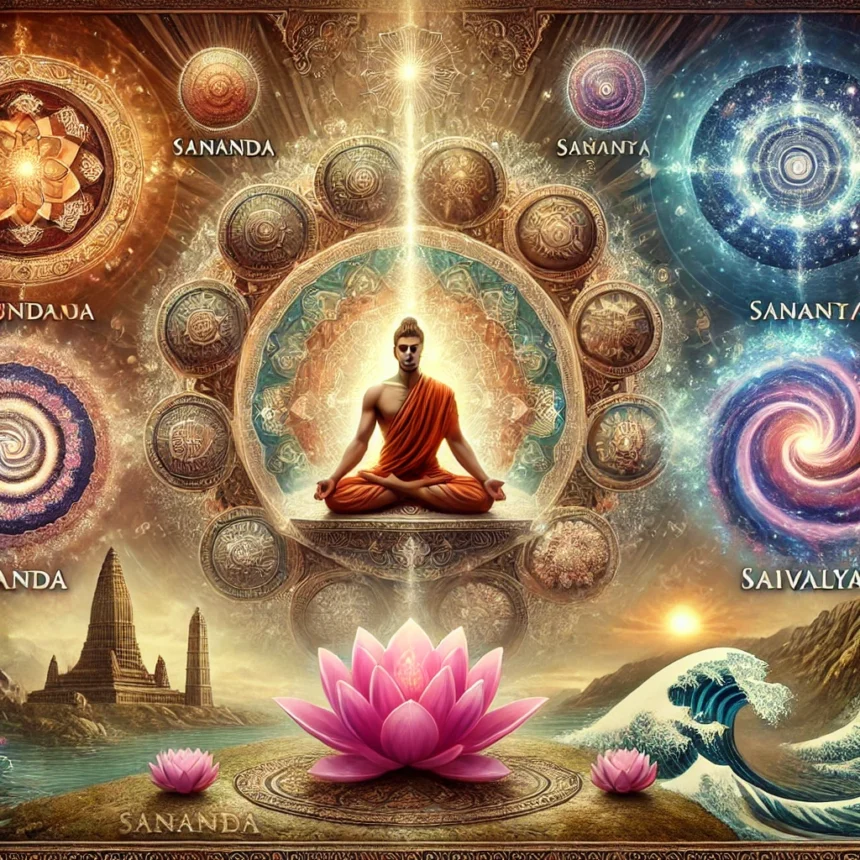Samadhi: A Deep Dive into Samprajnata Samadhi and Yoga Sutra 1.17
Navigating to Samprajnata Samadhi
This blog continues our in-depth exploration of Patanjali’s Yoga Sutras, particularly focusing on the transformative journey outlined in Sutra 1.17. In the previous two parts, we discussed the foundational and advanced stages of Samprajnata Samadhi, detailing the four varieties—Savitarka, Nirvitarka, Savichara, and Nirvichara—and delving into the refined stages of Sananda and Sasmita. These stages set the groundwork for transcending the limitations of the mind and ego.
In this final part, we delve deeper into the culmination of Sutra 1.17, exploring further on Asmita Samadhi and its role in navigating toward Kaivalya, the ultimate state of liberation. This blog ties together the concepts explored in earlier discussions, providing a comprehensive understanding of the advanced meditative states within Samprajnata Samadhi and their relevance to achieving self-realization.
Building Continuity: Navigating from Samprajnata Samadhi to Liberation
The journey of Samadhi, as articulated in Patanjali’s Yoga Sutra 1.17, underscores a meticulously structured progression through meditative states. In the earlier discussions, we unraveled the stages of Samprajnata Samadhi (सम्प्रज्ञा-समाधि), including Savitarka Samadhi, Nirvitarka Samadhi, Savichara Samadhi, and Nirvichara Samadhi, before delving into the refined realms of Sananda Samadhi and Sasmita Samadhi. These stages collectively prepare practitioners for the transformative experience of Asmita Samadhi.
This blog builds upon that foundation, bringing the focus to Asmita Samadhi as the culmination of the meditative journey and its role in leading practitioners toward Kaivalya, the ultimate state of liberation. By examining how each meditative stage integrates into the broader yogic framework, we explore how practitioners move beyond the limitations of the individual self, paving the way for profound self-realization.
The exploration also highlights the interconnectedness of these stages and their cumulative role in the spiritual journey, ensuring that each step reinforces the ultimate purpose of transcending the self and achieving freedom. This continuity reflects the holistic wisdom of Patanjali’s teachings and guides the practitioner toward unlocking their fullest potential.
The Path to Kaivalya: Unlocking the Ultimate Goal of Yogic Practice
Kaivalya represents the ultimate goal of Yogic practice, where the practitioner experiences a profound sense of liberation and connection with the universe. This state is achieved through the deepening of meditation, where the practitioner transcends the limitations of the individual self. By navigating the various states of Samprajnata Samadhi, the practitioner can ultimately attain Kaivalya, realizing their true nature and experiencing a profound sense of freedom and liberation.
Realizing the States of Samprajnata Samadhi: A Journey of Self-Discovery
The states of Samprajnata Samadhi represent a series of profound meditative experiences that allow the practitioner to transcend the limitations of the individual self. By deepening their practice and navigating these various states, the practitioner can gain insight into the true nature of reality, ultimately realizing their own true nature and achieving liberation.
The Role of Samprajnata Samadhi in Achieving Kaivalya
Samprajnata Samadhi is foundation course for achieving Kaivalya, as it allows the practitioner to transcend the limitations of the individual self and experience a profound sense of connection with the universe. By navigating the various states of Samprajnata Samadhi, the practitioner can ultimately attain Kaivalya, realizing their true nature and experiencing a profound sense of freedom and liberation.
Practical Steps and Techniques for Deepening Meditation
Swami Vivekananda, a revered yogic master, offers practical guidance on practicing meditation, emphasizing the importance of preparatory steps and mental discipline. By following these guidelines, practitioners can deepen their meditation practice, navigate the various states of Samprajnata Samadhi, and move closer to achieving liberation.
Preparatory Steps for Entering the States of Samprajnata Samadhi
To enter the states of Samprajnata Samadhi, practitioners must first prepare themselves through a series of preparatory steps. These steps include:
- Establishing a regular meditation practice: Regular practice helps to calm the mind, focus the attention, and prepare the body for deeper states of meditation.
- Cultivating mental discipline: Mental discipline involves developing the ability to focus the attention, calm the mind, and overcome distractions.
- Practicing pranayama and asana: Pranayama (breath control) and asana (posture) help to balance the energies, calm the mind, and prepare the body for deeper states of meditation.
These preparatory steps lay a strong foundation for accessing the transformative states of Samprajnata Samadhi.
Techniques for Deepening Meditation and Navigating the States of Samprajnata Samadhi
Once the preparatory steps have been established, practitioners can use various techniques to deepen their meditation practice and navigate the states of Samprajnata Samadhi. These techniques include:
- Focusing on the breath: Focusing on the breath helps to calm the mind, focus the attention, and enter deeper states of meditation.
- Using visualization techniques: Visualization techniques involve using the imagination to create vivid mental images, helping to focus the attention and enter deeper states of meditation.
- Practicing mantra repetition: Mantra repetition involves repeating sacred sounds or phrases, helping to calm the mind, focus the attention, and enter deeper states of meditation.
These techniques enhance focus and clarity, guiding practitioners seamlessly through the transformative states of Samprajnata Samadhi.
The Role of Ethics and Detachment in Achieving Samprajnata Samadhi
Ethical living and detachment from material desires are essential prerequisites for deep meditation and spiritual liberation. By cultivating these qualities, practitioners can create a conducive environment for meditation, allowing them to deepen their practice, navigate the various states of Samprajnata Samadhi, and ultimately achieve liberation.
The Importance of Ethical Living
Ethical living involves embracing a set of principles that guide our interactions with others and the world around us. By living an ethical life, practitioners can:
- Cultivate a sense of compassion and empathy: Ethical living helps practitioners develop a deeper understanding of the interconnectedness of all beings.
- Develop self-awareness and introspection: Ethical living encourages practitioners to examine their thoughts, words, and actions, and to take responsibility for their impact on others.
- Create a positive and supportive environment: Ethical living helps practitioners build strong, positive relationships with others, creating a supportive environment that fosters spiritual growth.
- Less chances of Slippage: Ethical living cultivates a positive inner self, minimizing distractions and reducing the chances of slippage on the transformative path to Kaivalya.
Ethical living serves as a steady foundation, fostering spiritual growth and ensuring alignment with the ultimate goal of Kaivalya.
The Power of Detachment
Detachment from material desires is another essential prerequisite for deep meditation and spiritual liberation. By cultivating detachment, practitioners can:
- Transcend attachment to worldly possessions: Detachment helps practitioners recognize that true happiness and fulfillment cannot be found in material possessions.
- Develop a sense of inner peace and contentment: Detachment allows practitioners to cultivate a deep sense of inner peace and contentment, regardless of external circumstances.
- Focus on the pursuit of spiritual growth: Detachment enables practitioners to focus their energy and attention on the pursuit of spiritual growth, rather than being distracted by material desires.
Detachment paves the way for inner peace and focused spiritual growth, guiding practitioners closer to the ultimate goal of liberation.
By embracing ethical living and detachment, practitioners can create a strong foundation for their spiritual practice, allowing them to navigate the various states of Samprajnata Samadhi and, ultimately, achieve liberation.
Continuing the Journey Through Patanjali’s Yoga Sutras
This blog concludes our exploration of Patanjali’s Yoga Sutra 1.17, offering an integrated understanding of Samprajnata Samadhi—from its foundational stages to its culmination in Asmita Samadhi and its role in achieving Kaivalya. However, this is only one step in the transformative journey outlined in the Yoga Sutras.
Each sutra presents deeper layers of wisdom and practical guidance for spiritual growth. The teachings, when practiced with discipline and introspection, guide seekers toward self-realization and liberation. Our next exploration will continue unraveling Patanjali’s profound insights, sutra by sutra, illuminating the timeless path to inner freedom and universal connection. Stay tuned as we delve further into the intricate wisdom of this remarkable text.
Feature Image: Click here to view the image.
Visit our YouTube Channel by clicking here and Video related to the Blog here.
Click here to visit our Medium channel.
Follow us on our social median handles
Glossary of Terms
- Asmita (अस्मिता) – ego or the sense of individuality
- Asmita Samadhi (अस्मित समाधि) – a state of refined awareness or meditation beyond ego-identification
- Kaivalya (कैवल्य) – liberation or isolation of the pure consciousness from the material world
- Patanjali (पातञ्जलि) – the ancient Indian sage and author of the Yoga Sutras
- Pranayama (प्राणायाम) – breath control or regulation of the life force
- Samadhi (समाधि) – a state of profound meditation or absorption in the universe
- Samprajnata Samadhi (सम्प्रज्ञात समाधि) – a state of cognitive absorption or meditation with awareness
- Sananda Samadhi (सानन्द समाधि) – a state of blissful meditation or joyous absorption
- Sasmita Samadhi (सस्मित समाधि) – a state of ego-transcendence or meditation with a subtle smile
- Siddhis (सिद्धि) – extraordinary abilities or occult powers that arise from intense spiritual practice
- Sutra (सूत्र) – a verse or aphorism from the Yoga Sutras of Patanjali
- Yamas (यम) – ethical disciplines or moral principles, such as non-violence and truthfulness
Top #Tags: #SamadhiStages #PatanjaliYogaSutras #MeditationJourney #SpiritualLiberation #YogaPhilosophy



Leave a Reply